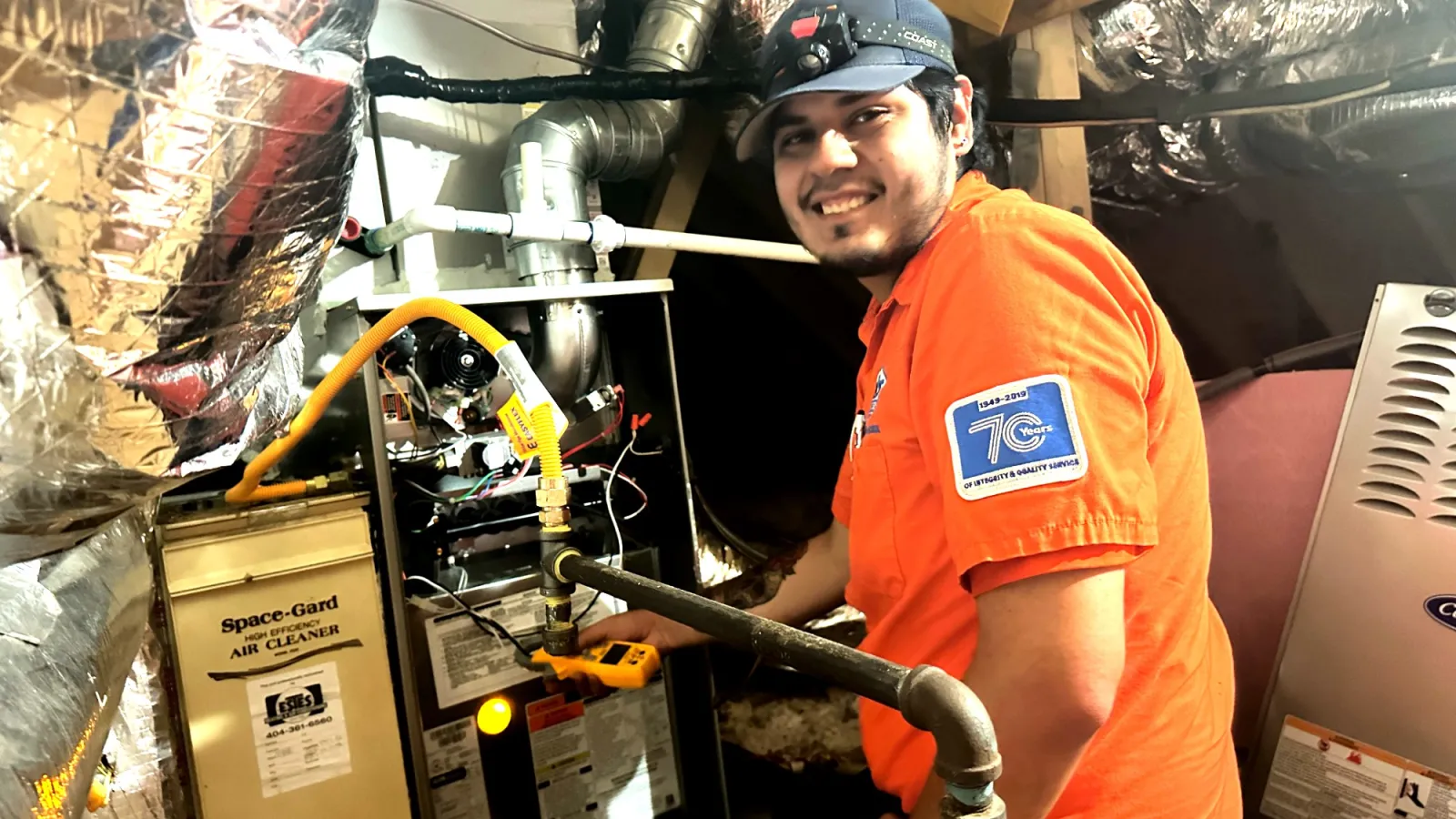What does an air handler do? Many Atlanta homeowners don’t know much about this important HVAC equipment, let alone what it does exactly. Our NATE-certified HVAC techs explain all about these systems.
What Is an Air Handler?
In its most straightforward definition, the air handler works with the heating and cooling unit to deliver controlled climate air throughout your home. It’s a system used locally with your current heating and cooling system. Installation typically occurs in well-ventilated areas, or areas without condensation or humidity in your home.
These units work to regulate the temperature of the air before sending it through various ducts in your ventilation system. As the air moves through the handler, it passes through a filter to trap dirt and debris before circulating throughout your ductwork. By catching and eliminating pollutants before the air passes through the ducts, your AC will perform more efficiently, and you will enjoy higher quality air in your home.
What’s the Difference Between an Air Conditioner and an Air Handler?
They perform different processes, yet some mistakenly believe these systems are one in the same. In reality, they are two systems that work together. The air conditioner is the outdoor portion of a home’s cooling system, while the air handler is the indoor portion. Both systems are linked by refrigerant lines. Handlers help facilitate the cooling process.
To start the cooling process, refrigerant in the unit’s evaporator coils absorb heat from airflow. The refrigerant then cycles through the lines to the outdoor AC. At the outdoor unit, the air conditioner’s compressor raises the temperature and pressure of the refrigerant and sends it to the air conditioner’s condenser coils. The condenser coils allow heat to be released from the refrigerant into the outside air. This lowers the refrigerant’s temperature and pressure before it cycles back indoors to the air handler to repeat the process for cooling.
Components of an Air Handler
There are three main components:
- Air filter
- Blower
- Coils
Air Filter
Your HVAC system’s air filter sits within the air handler between the fan and intake ducting. Air that is drawn into the HVAC system first passes through the filter to remove any contaminants, which protects the system.
Blower
Once air is conditioned by the HVAC system, the blower fan within the device is responsible for circulating this air out of the system, into the ductwork, and on to your living areas throughout the home. One of its jobs is to circulate the air conditioned by your AC or furnace.
Evaporator Coils
The evaporator coils (also called indoor coils) contain low-pressure, low-temperature refrigerant gas. As air passes over the evaporator coils, excess heat is absorbed by the refrigerant to cool the air. One of the primary elements of an air handler is it absorbs heat to start the cooling process.
The Different Types of Air Handlers
Different types of air handlers are available with varying features depending on what your HVAC system needs.
- A single-speed unit has a motor and a fan, which operates at one continuous speed.
- A five-speed unit offers several speeds and provides greater accuracy when operating. With more speeds, this device is more effective in circulating the indoor air throughout every room in your home, and the process is more efficient and quiet.
- A variable-speed model allows the unit to operate with differing speeds, which guarantees precise function to meet any requirement. With a variable-speed model, it can adjust to varying humidity levels while keeping consistent temperatures and healthier indoor air quality.
How Does an Air Handler Impact My HVAC System?
Air handlers have the ability to either make or break your heating and air conditioning system. For a central air system to operate at its best, all components of the system must be running at peak performance and efficiency. When units aren’t properly maintained, they suffer damaged components and result in your HVAC unit operating less efficiently. When the parts inside an handler are worn out or compromised, it prevents it from regulating the temperature and dispersal of indoor air throughout your home.
Air handler issues which impact central air systems’ performance may include:
- A faulty blower motor that doesn’t circulate cool air properly or draws excess power to do its job.
- Evaporator coils covered in debris or not functioning properly can limit the system’s ability to exchange heat properly.
- Dirty filters, which prevent air from flowing through the system correctly. This forces the central air system to use more energy to generate cool air for the home.
Estes Services knows the importance your air handler plays in the operation of your heating/air conditioning system. We provide routine maintenance to keep all the components in your unit working well so your unit can function smoothly with your HVAC unit. If your air handler is old or beyond repair, it’s time to upgrade!
When Should I Replace My Air Handler?
Older components of central air systems simply do not perform as well as newer ones. Over time, air handlers lose effectiveness, and older models do not have the advanced technology newer ones do. Older units are less effective to filter out contaminants, reduce noise and generate superior cooling performance.
When you upgrade your home’s air handler, it gives your central air system the high-performing components to deliver cool comfort to your home. Additionally, it helps to keep your energy consumption at a minimum.
When replacing either the air handler or the HVAC system, it’s best to replace both at the same time. When units are installed together, they also offer similar warranties to benefit you as a homeowner.
An upgrade to a higher-efficiency unit improves the performance of central air systems, especially when all components are properly matched. Replacing one and not the other compromises the unit’s efficiency and costs you more money on your energy bill in the long run. When replaced with AC units or heat pumps, a new unit is needed about every 10 to 12 years.
Air Handler Installation: Matching One with Your Central Air System
To gain the best performance from central air systems, air handlers and cooling components should be properly paired. Manufacturers design handlers and outdoor heat pumps and condensing units to work optimally as a matched system. When replacing your unit, it’s best to replace all central air system components, and vice versa if you’re replacing the outdoor components.
Matching air handlers with central air systems is vital to air conditioning system performance in many ways. The efficiency ratings of central air systems are based on the performance of a matched system. Unless you make sure to match the indoor and outdoor components of a central air system, the system will not generate the exact efficiency you expect. Each part of what an air handler does is not conducted as efficiently when units are not matched.
Estes Services’ NATE-certified technicians ensure proper coupling between air handlers and central air systems to deliver the peak performance you expect. We help homeowners select high-performance equipment to deliver energy efficient cooling power for years to come.
Quality Atlanta Air Handler Service
Now that you understand what an air handler does, you see the importance of this key HVAC equipment. Don’t risk the efficiency of your central heating and air system with the wrong unit . Estes Services’ NATE-certified technicians help you choose the right new heating and cooling equipment and perfectly match it with a new unit to deliver ultimate system performance and efficiency.
If you have questions about air handlers or would like an estimate for replacement, contact us today!


